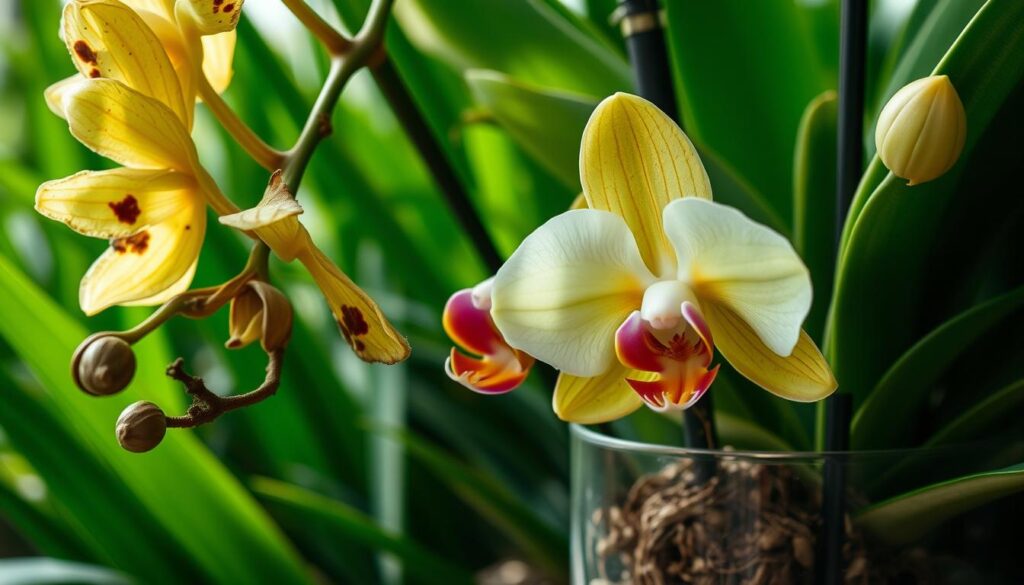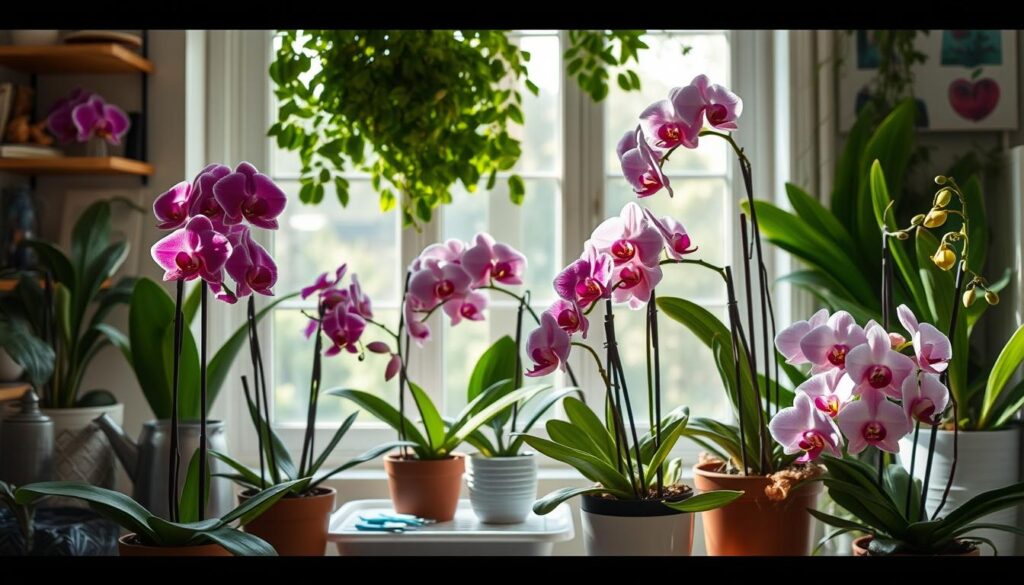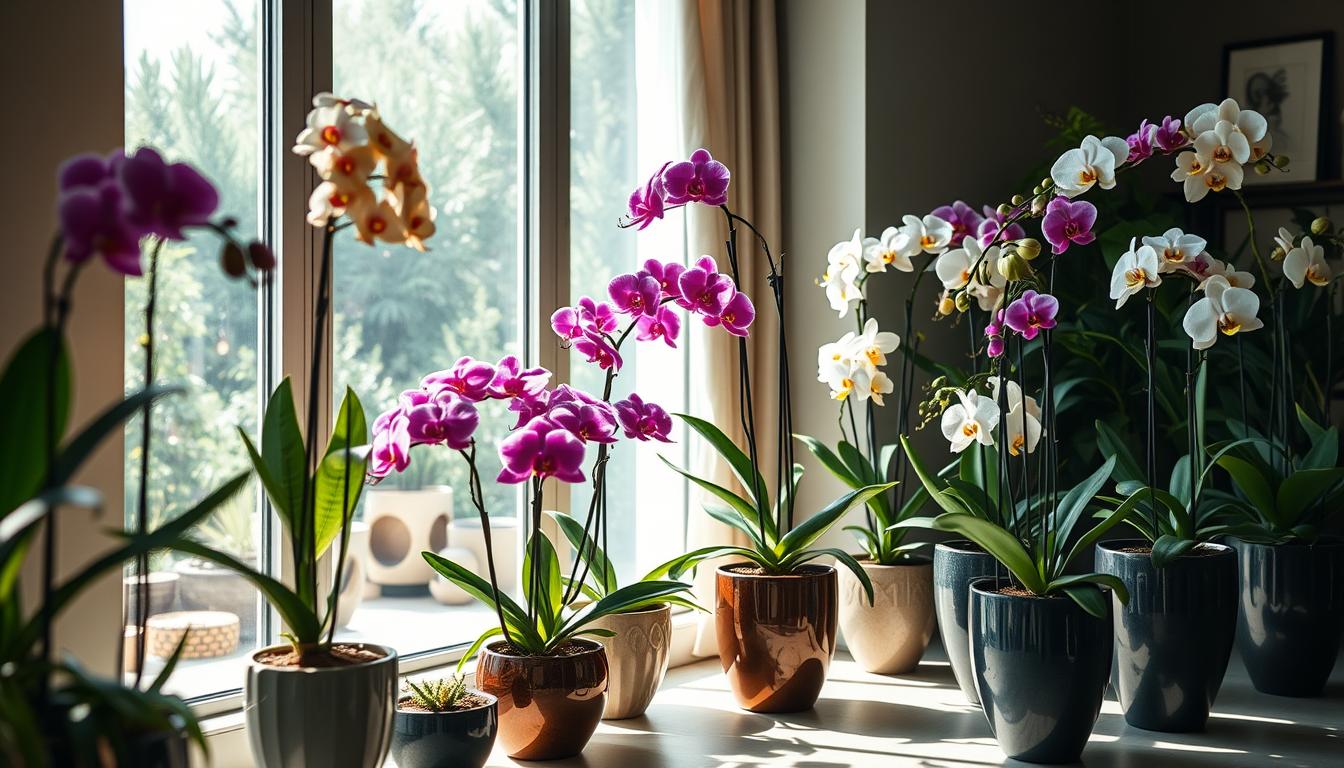Imagine having a beautiful orchid at home. It adds luxury and freshness. With over 25,000 orchid types, you can pick the perfect one for you.
Orchids are easy to care for. They can live for years with the right care. This makes them a smart choice for your home.
Orchids are stunning and can grow in different light. They need little water and can handle many temperatures and humidity levels. This makes them perfect for busy people who want elegance without much work.
Orchids are great for any room. They are safe for pets and easy to find. They also bloom for a long time, making them a great choice for your home.
Discovering the Enchanting World of Orchids
As you explore orchids, you’ll find a world of beauty. There are over 25,000 species and more than 100,000 hybrids. Orchids range from easy-to-care-for Phalaenopsis to exotic Vanda. Knowing about different orchids helps in growing and learning about them.
Orchids have been around for thousands of years. In ancient Greece, they meant virility. In China, they stood for elegance. Today, they’re loved for their beauty and luxury feel. Learning about orchid care and types is rewarding. For more on repotting plants, including orchids, check this guide.
The Rich History of Orchid Cultivation
Orchid growing has a long history, starting in ancient China. Over time, new ways to grow orchids have been found. Knowing their history helps us appreciate orchids more.
Understanding Different Orchid Families
Orchids belong to several families, each with its own traits. Phalaenopsis, Dendrobium, and Vanda are common types. Phalaenopsis orchids have long-lasting flowers. Dendrobium orchids have delicate flowers. Vanda orchids are known for their bright colors. Knowing about these families helps in caring for orchids.
Why Orchids Make Perfect Indoor Plants
Orchids are great for indoor spaces, adding elegance. They need only moderate water and food. Orchids can grow well in many places, from sunny spots to shaded areas. They’re perfect for adding color or luxury to your home. Here are some reasons orchids are good indoor plants:
- Air-purifying properties
- Low-maintenance care
- Long-lasting blooms
- Vibrant colors and unique appearance
Creating the Perfect Environment for Your Orchid
To make your orchid happy, think about orchid potting, orchid watering, and orchid fertilizing. The right soil is key. It should let water drain and air get in. The soil should hold some water but not too much.
Watering your orchid right is important. Too much water can hurt the roots. Not enough water can make the leaves dry out. Most orchids need water once a week. But, this can change based on the type of orchid and your home’s humidity.
Using the right fertilizer is also important. Use a special orchid fertilizer. Regular fertilizers have Urea, which orchids don’t use well.
- Use a clear pot to see the roots and help with photosynthesis.
- Put your orchid on a humidity tray or with other plants for more moisture.
- Give your orchid the right amount of light. Not enough light can stop it from blooming again.
- Fertilize your orchid weakly and weekly with a little bit of fertilizer.
Follow these tips to make your orchid happy. Watch how your orchid reacts to its home. Change things as needed to give it the best care.
Essential Orchid Care Guidelines
Starting your orchid journey? Knowing the basics of orchid care is key. It’s about giving them the right light, water, and food. With over 22,000 orchid types, each needs something special. But, some rules work for most.
Watering your orchid right is super important. Too much water can harm them. Most need water once a week. Use warm water to help dissolve fertilizer.
For orchid fertilizing, go weak and weekly. A little bit of fertilizer is best for growth.
- Give them bright, indirect light. Direct sun can burn them.
- Keep the air humid, at least 40%.
- Use a mix that drains well, like fir bark, to avoid soggy soil.
Stick to these orchid care tips to help your orchid thrive. Fertilize often and ask experts for orchid watering and orchid fertilizing tips.
Mastering Orchid Potting and Soil Requirements
Choosing the right orchid potting is key for your orchid’s health. A good potting mix helps your orchid grow and bloom well. Use a mix of orchid bark and organic perlite, like “All Purpose Orchid Mix Potting Soil Indoor Plants”.
It’s important to repot your orchid regularly. This keeps it healthy and stops the potting mix from breaking down. You should repot every 1 to 2 years, depending on your orchid’s type and where it grows. Look for tangled roots or white roots coming out of the pot.
- Choose a pot that is 1 to 2 inches larger in diameter than the existing pot.
- Select a well-draining potting mix, such as a combination of bark and sphagnum moss.
- Sterilize the potting mix in boiling water to eliminate pathogens before use.
By following these tips and using the right orchid potting and orchid soil, your orchid will thrive. Repot every 1 to 2 years. Pick a pot that fits your orchid’s roots without being too tight.
Feeding Your Orchid for Optimal Growth
To help your orchid grow well, give it the right orchid nutrients. Knowing what your orchid needs is key. They need a special mix of nutrients for flowers to bloom.
A balanced fertilizer with a 20-20-20 ratio works best for most orchids. But, don’t overdo it. Too much fertilizer can harm your orchid.
Don’t over-fertilize your orchid. This can slow it down. Mix the fertilizer with water carefully. Use bloom boosters for more flowers. Brands like Grow More and Dyna-Gro Orchid Pro are good choices.
- Apply fertilizers weekly, with recommendations supporting twice-weekly applications for optimal growth.
- Use a balanced fertilizer with a ratio of 20-20-20 for most orchids.
- Apply bloom booster fertilizers to enhance bloom production.
- Avoid over-fertilization, which can stunt orchid growth.
Follow these tips to help your orchid grow. Give it the right orchid nutrients for beautiful blooms. Adjust how often you fertilize based on your orchid’s needs and where it’s kept.
| Fertilizer Type | Application Frequency | Recommended Ratio |
|---|---|---|
| Balanced Fertilizer | Weekly | 20-20-20 |
| Bloom Booster Fertilizer | Twice a month | Higher Phosphorus content |
Troubleshooting Common Orchid Problems
When you care for your orchid, you might face some issues. These can be diseases, pests, or problems with growth. It’s important to solve these problems quickly to keep your orchid healthy.
Some common issues are black spots on leaves and 
To fix these problems, try these steps:
- Keep the sick orchid away from others to stop the spread
- Use 70% isopropyl alcohol or soapy water to fight pests
- Change how often you water and the humidity to avoid too much or too little
Knowing about these common problems helps. Taking action early keeps your orchid looking great for a long time.
Advanced Orchid Propagation Methods
As you get better at growing orchids, you might want to try new ways to share them. One way is orchid division. This means cutting a big orchid into smaller parts. Each part gets its own roots and can grow on its own.
Another method is orchid keiki development. This is when a small plant grows on the big one. It waits until it has 2-3 inches of roots before it’s cut off. You can learn more about orchid propagation methods, including keiki development and division.
- Use the right techniques and materials to minimize the risk of disease and infection.
- Provide high humidity and warm temperatures to promote healthy growth.
- Water lightly after division to settle the roots and prevent root rot.
| Method | Description |
|---|---|
| Orchid Division | Dividing a mature orchid into smaller sections, each with its own roots and growth points. |
| Orchid Keiki Development | Allowing a keiki to develop its own roots before separating it from the mother plant. |
Seasonal Care and Blooming Cycles
Exploring orchids means learning about orchid seasonal care and orchid blooming cycles. Each type blooms at different times. Knowing when to care for your orchid is key.
Spring is when Cattleya, Epidendrum, Phalaenopsis, Vanda, and late-blooming Paphs bloom. As seasons change, so do your orchid’s needs. In summer, water more because it loses moisture. Move high-light orchids outside.
In fall, let Phalaenopsis orchids get a little cold. Winter is when you must watch for diseases and cold damage. For more orchid care tips, check online.
Here are some tips for orchid growth and blooming:
* Repot every 1-2 years
* Fertilize more in summer
* Keep temperatures between 50° to 80° F
* Humidity should be 55% to 75%
* Watch for new leaves or bloom spikes
Conclusion: Embracing the Rewarding Journey of Orchid Growing
Starting your journey in orchid growing is exciting. There are over 25,000 orchid types to explore. It’s a chance to grow and learn a lot.
Looking after an orchid can be very rewarding. You get to see a small bud turn into a beautiful flower. With the right care and patience, your orchids can bloom for many years.
Every orchid is different, so you need to learn how to care for each one. This way, they can grow and stay healthy.
Enjoy the journey of growing orchids. Celebrate when you succeed and don’t get too upset when you face challenges. Learning about orchids is a lifelong adventure.
By diving into orchid growing, you’ll not only have beautiful plants. You’ll also feel proud and fulfilled.
FAQ
What are the different types of orchids and their unique characteristics?
Why are orchids considered perfect indoor plants?
What are the lighting, temperature, and humidity requirements for growing orchids?
How do I properly water and fertilize my orchid?
What is the best potting medium for my orchid, and when should I repot it?
How can I troubleshoot common orchid problems like diseases, pests, and growth issues?
What are the advanced methods for propagating orchids?
How do I adjust my orchid’s care and maintenance for different seasons?
If you are really in love with gardening see Michelles YouTube Channel for all things plants.
If you would like to check out other beautiful members of the Succulents category look here at our article of 8 Stunning Flowing Houseplants





Pingback: 8 Stunning Flowering Indoor Plants to Brighten Your Home - Trusted House Plant Guide
Pingback: The Ultimate Guide to Houseplants: 100 Best Indoor Plants for Every Home - Trusted House Plant Guide